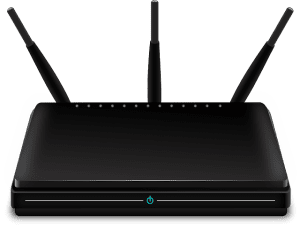If you have ever used the internet, then you have used a router. While we all probably have one of these devices in our home, you probably have not taken much time to think about what it is and how it actually works. A router is a device that communicates between the internet and all of the WiFi enabled devices (cell phones, laptops, smart TVs, tablets, etc.). It “routes” traffic, as the name implies, between the various devices and the internet.
If you have the right type of router enabled in your home network, you may be able to enjoy lightning fast internet service, avoid Wi-Fi dead spots around your home, and help keep your family safe from data breaches and cyberthreats.
It does not require a computer science degree to understand what a good router has to offer. Instead, you just need to know what you need it for. Having a solid understanding of how routers work will help you choose the right equipment for your home or place of business.
The average American home has a wide variety of internet-connected devices: personal computers, tablets, smartphones, printers, thermostats, smart TVs, and all sorts of other devices. Connected to a router, all of these devices convene to form a network. The router “routes” incoming and outgoing internet traffic on your home or office’s network in the fastest and most efficient way it can.
The data and information traveling on your home or office network could be an email, a movie you are streaming, or a live feed from your doggie cam, all of these different tasks which takes up varying amounts of bandwidth. Routing that information and delivering quickly and correctly is a big task, and the demand for faster, more efficient internet speeds is only increasing. If you are asking more of your router, like in an Internet of Things network, you are going to need one that is up to the challenge. You might want to invest in a high quality industrial-grade router like Cradlepoint or Antaira.
What to Look for in a Router
For the most part, your internet service providers (ISPs) provide you with a router and a modem, or possibly a combination of the two devices, for a subscription fee that over time, can add up. While they may be easier to install, these routers may not be the best fit for your specific usage needs, so you might consider purchasing a router that better fits your internet and data requirements. Before jumping into purchasing a router, here are a few things to look for:
Wi-Fi Coverage and Dead Zones
The strength of a Wi-Fi signal within your home or office largely depends on how big your home is and what obstacles keep signals from reaching your devices in certain areas of your home. Fireplaces, mirrors, and thick walls are a few examples of barriers that block Wi-Fi signals. Look for a router that has the capability to reach the far corners of your home. In addition, make sure to look for a router that includes a mesh network to extend your home’s Wi-Fi capabilities across the enter space.
Wi-Fi performance
Router technology has changed a lot over the years .You are going to want to make sure you have a router that uses the latest technology, especially if you are using it for commercial or industrial networking. You might want a router with MIMO capabilities if your network is going to be heavily trafficked and full of devices.






